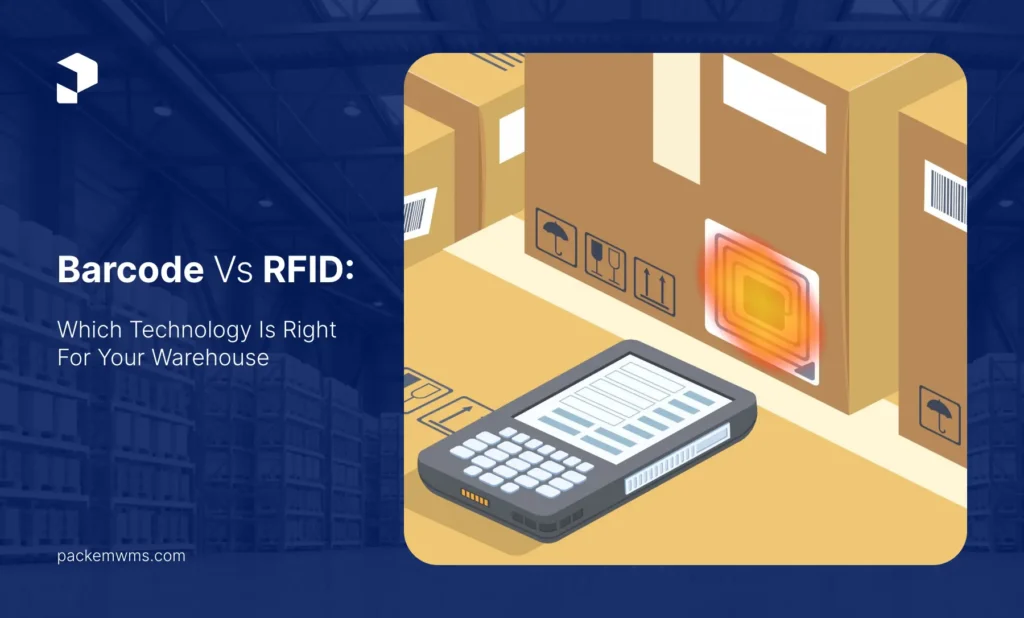Running a warehouse? Confused about barcodes and RFID for your inventory tracking? This choice significantly impacts efficiency, costs, and overall operations.
Here’s the breakdown: Let’s find which one is a perfect fit for your warehouse.
Choosing the Right Technology for Your Warehouse: Barcode vs. RFID
Cut to the chase. You’re here because you’re dealing with some serious problems:
- Is your inventory accuracy enough to make you scream?
- Are you spending valuable time just manually scanning stuff?
- Is your warehouse efficiency still stuck in the Stone Age?
- Are you bleeding money over lost or missing items?
If you’re nodding your head, then you are in the right place. Let’s get down to serious business and figure out which technology will become your warehouse’s new best friend.
Introduction to Barcode and RFID Technologies
What are Barcodes?
Barcodes are those ubiquitous striped patterns found on nearly every product. They’ve been the go-to for inventory management for decades, offering simplicity, affordability, and universal recognition.
Barcode scanners provide instant translation of the pattern of black and white into a product identifier and thus are ideally suited for applications where huge volumes are involved. Their Achilles’ heel, though, is that they require a direct line-of-sight to scan.
What is RFID?
RFID is revolutionizing the way we manage inventory. Imagine a technology that can identify and track items without needing a direct view. That’s the magic of RFID. These tiny tags, embedded with unique identifiers, communicate with RFID readers using radio waves. While RFID boasts impressive features like multi-item scanning and extended data storage, it comes at a slightly higher cost compared to barcodes.
Comparison of Barcode and RFID Technologies
1. Cost Considerations
Let’s talk dollars and cents—barcodes are cheap. You can set up a barcode system without having to break your pocket. RFID? Not so much. Setup and equipment costs are higher initially.
2. Data Storage Capabilities
Barcodes are like simple name tags – they hold just the bare minimum, typically a unique product identifier. But RFID tags are like digital dossiers. They can store a wealth of information, including product details, serial numbers, manufacturing dates, and even maintenance history. This rich data allows for better tracking, analysis, and decision-making.
3. Scanning Efficiency
Barcodes have a major limitation: line-of-sight scanning. Trying to scan a curved surface or an item buried in a box is frustrating and time-consuming.
RFID takes the hassle out of scanning. It uses radio waves to identify tags, so hidden items and multiple items close together can be scanned simultaneously, boosting overall efficiency.
4. Durability and Lifespan
Barcodes can get damaged pretty easily. A scratch or tear and it’s game over. On the contrary, RFID tags are rugged in nature and definitely would be able to bear the harsh environments for a longer and more reliable time.
5. Implementation and Scalability
Setting up a barcode system is no more difficult than plugging in a new coffee maker. On the other hand, RFID systems can get much more complicated in their setup, as there is extra hardware and software to implement. If you’re planning on growing, RFID might be worth the investment.
Experience the simplest inventory management software.
Are you ready to transform how your business does inventory?
Barcodes and RFID: Pros and Cons
Pros of Barcodes
- Cost-effective
- Simple to implement
- Widely accepted and used
Cons of Barcodes
- Requires line-of-sight scanning
- Limited data storage
- Prone to damage
Pros of RFID
- No line-of-sight required
- High data storage capacity
- Durable and long-lasting
Cons of RFID
- Higher initial costs
- Complex setup
- Potential for interference
Factors to Consider When Choosing Between Barcode and RFID
1. Size of the Warehouse
Scanning multiple items all at one time and being able to scale for future growth are big advantages of RFID tagging in sprawling warehouses, barcodes might be sufficient in smaller operations, especially with their lower cost.
2. Budget Constraints
Barcodes are the clear winner on upfront costs. RFID’s initial investment is higher, but its potential increase in efficiency and capture of data can eventually decrease the cost over time.
3. Type of Inventory
For fast-moving items, the improved tracking and security of RFID can be important. For everyday, low-cost items, barcodes offer a practical and economical solution.
4. Desired Efficiency
RFID has an ability to scan multiple items, without needing a direct line-of-sight, significantly boosts efficiency compared to barcode scanning.
Future Trends in Warehouse Technology
The future of warehousing will belong to those that leverage technology to build new efficiency, accuracy, and automation.
Integration with IoT
IoT interconnects devices and sensors within a warehouse, making inventories traceable in real time, creating automated workflows, and guaranteeing predictive maintenance. Imagine robots receiving and storing goods in a warehouse; when it is time to restock, an alert is triggered in an automated manner.
Advancements in Barcode Technology
RFID tags are much more resistant to strains and efficient methods of inventory management compared to traditional barcodes. Unlike barcodes, which need to be in the line of sight while scanning, RFID tags can be read at a distance for quicker and more accurate stock checks and real-time location tracking.
Hybrid Systems
Some warehouses have taken to a hybrid system wherein both barcodes and RFID are used. The former is cost-effective in some applications where high-value items or complex logistics are involved, while the latter offers better tracking capabilities. This hybrid approach yields the twin benefit of performance optimization with cost efficiency.
FAQ's
Yes, initial training is necessary to familiarize your staff with RFID technology and procedures. Indeed, most RFID providers do offer different training programs in order to make this transition smoother and to better help extract all the benefits from the system.


